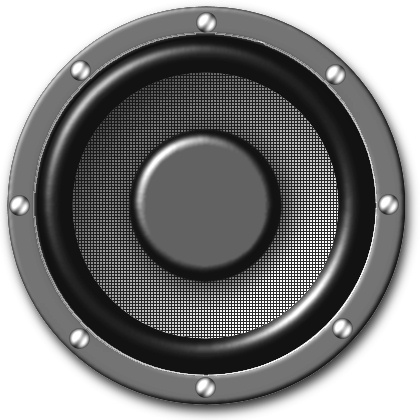Loudspeaker Enclosure Box Types
Loudspeaker box enclosures play a vital role in the following aspects:
When choosing a loudspeaker enclosure, it is essential to consider the following factors:
Infinite Baffle
Is defined as an enclosure that contains a larger volume of air than the Vas of the driver. You don't need to build a enclosure for
this type of audio loudspeaker. You simply mount them in the wall and use the wall cavity as the enclosure or if were talking about car audio speakers the trunk becomes
the enclosure. In general these enclosures have the least amount of sound coloration and they are inefficient because the rear energy which was never intended to be heard
by the listener is "wasted". The important thing to remember is to have the front and rear of the audio speaker isolated into different air spaces so the air from the
front of the audio speaker can't interact with the air at the rear of the audio speaker to avoid phase cancellation.
https://diyaudiospeakers.5150.ca/types.html

Sealed Enclosures (Acoustic Suspension)
Sealed Enclosures are completely airtight, providing tight bass response and accurate sound reproduction. They are often used in smaller speakers and
sub-woofers. This type is preferred due to the simplicity of it's design which promotes a smooth frequency response, excellent cone control which translates into accurate sound reproduction. The only downside to
this design is that it does this all at the expense of low efficiency. The volume of air within a sealed enclosure is less than the Vas of the driver; the air trapped in
the enclosure helps control the movement of the cone somewhat like a shock absorber controlling the springs on a car.
https://diyaudiospeakers.5150.ca/types.html

Vented Enclosures (Ported, Bass Reflex, Tuned or Tuned Ported)
Ported Enclosures have a port or vent that allows air to move in and out, extending the bass response. They are commonly used in larger speakers and in home theater systems.
This is a much harder design to "get it right" with (unless you got some good audio
loudspeaker software). In the first two designs the wave at the front of the audio speaker was used while the wave at the rear of the audio speaker was "thrown away".
Vented designs use this "thrown away' energy to enhance the overall sound of a audio loudspeaker (if properly designed) with better efficiency and deeper bass extension
from sound produce in the port. This is done by tuning the ports (length and diameter) so the rear wave pressure will produce a lower tuned frequency in the port. Put the
port somewhere close around the woofer, preferably just below it (within one foot). The direction the ports face (rear or front) is a personal design choice, and if the
need arises smaller multiple ports can be used in place of a larger single port. Variations of this design include the use of multiple rear chambers tuned to different
frequencies and passive radiators.
https://diyaudiospeakers.5150.ca/types.html
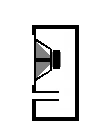
Passive Radiator
This is essentially a unpowered driver which replaces the port on a ported audio loudspeaker. It has the advantage over the port of
less distortion and it allows the loudspeaker to act with precision of a sealed enclosure without the loss of efficiency.
https://diyaudiospeakers.5150.ca/types.html>
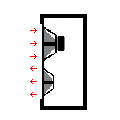
Isobaric
In this design the audio speakers face one another, one of them is in the enclosure. It's also wired out of phase; the speaker in the
enclosure is wired normally and the other one's wires get flipped around. This will allow them to move together in the same direction at the same time. This design may be
used when enclosure size must be small. This audio enclosure can be half the size of the regular audio enclosure box.
https://diyaudiospeakers.5150.ca/types.html
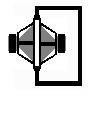
Dipole
This is for a "effect" rear surround sound home theater type of audio loudspeaker which "hides" the source of the sound very well. In this
design the drivers are fired out of phase with one another. As a result their is a "nil" or dead zone due to phase cancellation in the space between the loudspeakers which
unfortunately also kills a lot of the loudspeakers bass. This type of audio loudspeaker will give the desired effect only within a defined space and need special
considerations in their placement. Not intended to be used as a general audio loudspeaker.
https://diyaudiospeakers.5150.ca/types.html
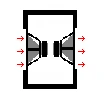
Bipole
Ported Enclosures have a port or vent that allows air to move in and out, extending the bass response. They are commonly used in larger speakers and home theater systems.
This type differs from dipolar in that both audio drivers fire in phase with one another "spraying" sound everywhere. Loudspeaker placement isn't
as critical as with the dipole, with a much wider listening space area and no loudspeaker bass reduction due to phase cancellation. Bipole speakers are a
excellent choice for a surround sound side speaker.
https://diyaudiospeakers.5150.ca/types.html

Bandpass
A combination of a sealed and a ported audio enclosure. Combining the two together will result in louder bass output than what the sealed
enclosure alone would put out. This type of audio enclosure is not used as true subwoofer because the frequencies that come out of the port are a limited to a very narrow
bandwidth. This design is often used to enhance the lower frequencies of smaller bookshelf type of audio loudspeakers.
https://diyaudiospeakers.5150.ca/types.html
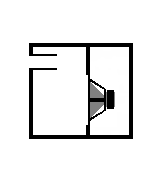
Sub-woofer
This is a special type of speaker designed to play the LFE audio channels found in some audio files such as Dolby Atmos, DTS-HD, DTS Master Audio, etc and that are encoded into movies and into some audio file formats. A sub-woofer will often make the audio sound unnatural or boomy if it is forced to play audio which does not have a sub-woofer LFE audio channel such as if you connected the speakers in parallel with the sub-woofer. Quality receivers allow you to connect to a sub out channel and then use the sub-woofer only when a LFE chanel is present.
Sub-woofer is often used to try to compensate for having small speakers which are trying to do a large speakers job. Small speakers just simply cannot put out deep low base like a larger speaker can.
The solution for better quality while listening to ordinary audio is to get bigger speakers, size does matter.
https://diyaudiospeakers.5150.ca/types.html
Center Channel
For home theater a good center channel is a must. The center channel is often referred to as the dialog channel and is important if you want clear dialog audio. Turn up the center channel
if you want to hear what the actors are saying or get a better (usually larger) center channel.
https://diyaudiospeakers.5150.ca/types.html
Transmission Line Enclosures
Transmission Line Enclosures use a long, folded tube to control the backwave of the speaker driver, resulting in smooth and extended bass
response and they are often complex and expensive to build.
Transmission line enclosures are a type of loudspeaker enclosure design that utilizes the principles of acoustic transmission lines to enhance the performance of the speaker, particularly in the low-frequency range. Transmission line enclosures are known for their ability to produce deep and extended bass response due to the controlled propagation of sound waves within the enclosure. While they can be more complex to design and build than other types of enclosures, the potential benefits make them a popular choice among audio enthusiasts and speaker manufacturers alike. The enclosure contains a long, folded pathway or duct, often filled with damping material, that allows sound waves from the rear of the speaker driver to travel through.
By carefully controlling the path of sound waves, transmission line enclosures can minimize unwanted resonances and distortions, resulting in cleaner and more accurate sound reproduction. Compared to sealed enclosures, transmission line enclosures can offer improved efficiency, meaning they can produce more sound output with the same amount of power.
Some Design Considerations Of Transmission Line Enclosures
Transmission line enclosures advantages;
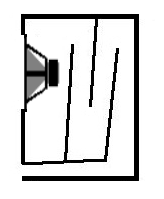
Horn Enclosures
Horn Enclosures use a horn-shaped structure to couple the speaker driver to the air, increasing efficiency and directivity. They are commonly used in
professional audio systems and public address systems.
https://diyaudiospeakers.5150.ca/types.html
Selecting The Best Drivers For Your Enclosure
This is very important and its worth repeating (Qtc 0.707 stuff); you must match your drivers to the enclosure and I am not just talking about the size of circular hole in the front of the audio speaker enclosure. Most audio drivers are now designed to be used in a specific type of enclosure with a specific volume (size). So when deciding upon your audio drivers you have to take into consideration the type of enclosure (ported, sealed) and the enclosure size recommended by the manufacturer. If their recommendations are not available you will have to take the other information that is given such as Fs, SPL, Vas, Qms, Qts, etc and figure that out for yourself. You can do that by using various complex mathematical equations or by simply plugging in the information about the driver into any of the many audio loudspeaker building software programs that are available.
Okay, you now know to match up your audio speaker drivers to the enclosure size and type recommended; you have to do that with the midrange audio speaker also if it is not-rear sealed . The reason why you build an enclosure within an enclosure for a non-rear sealed audio speaker is that you'll want to isolate the air spaces behind the driver and midrange from each other to prevent them from "pushing" on each other. The volume of air displaced by a large woofer moving in and out can destroy the much smaller midrange driver and even if it doesn't, they will interfere with one another causing distortions which is not a good thing to have happen.
Don't forget to add the total volume of the midrange enclosure to the audio speakers enclosure's total volume. Don't worry about building a separate enclosure for the
tweeter; every tweeter that I have ever seen is rear sealed so the driver's air pressure won't affect it.
https://diyaudiospeakers.5150.ca/types.html
Deciding On A Two or Three Way Speaker Design
This has to do with the numbers of ways the frequencies are divided (the audio crossover network); and generally to the amount of transducers (audio speakers) used;
Two-Way Loudspeaker Design
A Two-Way Audio loudspeaker uses a driver and a Tweeter. In the Two-way design the work of reproducing the total sound spectrum is divided between the two components. The driver may take the frequencies between 45Hz-2400Hz; the tweeter then must be able to handle the frequencies from 2.4Mhz and up. Often a sub-woofer is needed to enhance to lower frequencies because of the design limitations of the driver. This is because most audio drivers can't do a lot of different frequencies all at once well. A audio driver that can get low as 20Hz usually won't sound good at 1,500Hz. And most tweeters that can reach 30,000Hz or above often won't operate below 2,000Hz.
So most two-way audio loudspeaker are a compromise between the low and high frequency. But due to new advances in audio speaker technology a new generation of mid/woofers
and tweeters have come along that have much wider frequency ranges than ever dreamed of before. Because of this quality two-way audio loudspeakers can now begin to compete
with three-way audio loudspeaker systems.
https://diyaudiospeakers.5150.ca/types.html
Three-Way Loudspeaker Design
A Three-Way audio loudspeaker uses a woofer, midrange and a tweeter and is still considered superior over the Two-way design. The workload of reproducing the sound is
divided among the Three components. The woofer may handle between 20Hz to 800 Hz, the midrange handles the frequencies between 800Hz to around 5000Hz. The tweeter then is
left to deal with everything above 5000hz. This design has no compromises like that needed in the two-way system. Three-way or higher is the only way to go for a true full
range audio loudspeaker. Some people have taken this to the extreme and added more than three audio speaker components making a four or five-way loudspeaker!
https://diyaudiospeakers.5150.ca/types.html
Designing The Crossover Network
The big problem with the "more audio drivers are better" idea is in trying to design an acceptable crossover network. Two-way crossovers are easy, three-way are much more
difficult. Four-way and above higher order crossovers are usually only attempted by the "Pros" or hard core loudspeaker builders due to the "huge pain in the ass to design
successfully" factor involved.
https://diyaudiospeakers.5150.ca/types.html
Internal Box Bracing
Another very effective way to control audio enclosure resonance is through internal bracing. The best way of bracing is to design it into
the audio enclosure box from the start and not just add some cross bracing latter. Better quality audio cabinets use diagonal or planar
bracing which bonds all four sides of the audio enclosure box together. A simple often used method is to add bracing which is basically a
board with a hole cut in it. The hole space in the center of the board are needed to allow air movement in the audio enclosure box.
https://diyaudiospeakers.5150.ca/types.html
The Shape (Dimensions) Of The Enclosure Box
The Loudspeakers box shape also is a factor in limiting enclosure resonance. A cube is the absolute worse shape (unless your
designing a sub woofer) that a Loudspeaker could be due to the standing waves produced inside the audio enclosure box. In general try
to pattern your Loudspeakers to the golden rule ratio of (Heigh 2.618 : Width 1.618 : Depth 1) This ratio will minimize these standing
waves and the resulting enclosure resonance and distortion. You don't have to match the ratio exactly, but the closer the better.
https://diyaudiospeakers.5150.ca/types.html
Speaker Box Enclosure Mass Loading
Adding weight such as dry sand or lead shot into a special compartment at the base of the audio enclosure will benefit the loudspeaker by
increase it's effective mass. By adding mass to the loudspeaker structure it will act as an efficient absorber of vibrational energy. The
heavier an object is the more energy it takes to make it vibrate; so weight is a resonance dampener. By experimenting with the amount of the
fill material it is possible to fine tune the enclosure's tonal qualities to better match your own tastes or to help control some unpleasant
sounding resonance produced by your Loudspeaker enclosures. If you are determined to extract the absolute best performance that your
Loudspeakers can deliver, it is worth the effort to mass load your speakers.
https://diyaudiospeakers.5150.ca/types.html
Speaker Box Enclosure Material
Most Speaker builders would agree that medium density fiberboard (MDF) or medium density overlay (MDO) board is the product of choice.
This is due to it's relative low cost, and because the stuff is strong. Don't use particle board or cheap quality plywood. Higher quality
plywood that have no voids in the lamination's are acceptable; you can spot poor quality by checking for missing pieces of laminates that
have fallen out along its edges. Three quarters of an inch is the minimum board thickness that should ever be used because a strong and stiff
enclosure is needed to minimize enclosure resonance.
https://diyaudiospeakers.5150.ca/types
Speaker Alignment within the Box Enclosure
The tweeter, midrange and the woofer should be kept in a straight vertical line with one another; this is done to keep the sounds in-phase
with the listeners ear. The woofer sits nearer to the floor and the tweeter should be near ear level with the midrange in between the two.
Mount all the audio drivers close together; the sound quality is usually improved due to less phase shifting and better imaging.
https://diyaudiospeakers.5150.ca/types.html
Make the Speaker Box Enclosure Air Tight
Make the audio enclosure airtight (except for the port of course). Leaks will show them self as unwanted air noise and in more extreme cases
the leaks could effect the proper operation of the drivers and change the port frequency of base reflex Loudspeakers. Use caulking to
seal around the inner joints and any other place that air could escape.
https://diyaudiospeakers.5150.ca/types.html
If You Want "Big" Sound You Need Big Speakers
It's only logical that if you want big sound with deep clean base you need big Speakers. I have read claims by some builders that their 6.5 inch based or smaller Loudspeaker can match or exceed the sound quality and quantity of a much larger driver based Loudspeaker.
The laws of physics say higher frequencies don't require much air movement, but for every octave drop in the audio spectrum the driver has to be capable of moving 4 times more air to keep the same output level (loudness). Simply put, deep base requires you to move a lot of air, something a small audio driver cannot do so don't fight the real facts, just accept them.
So now your considering using a 15 inch audio driver in your loudspeakers but are concerned that your loudspeakers will have too much bass and
they will sound unnatural; don't worry, they won't. They will sound very similar to those quality 6.5 inch Speakers at low to mid volume
levels. They will just be more capable of delivering much louder clearer bass than the 6.5 inchers when asked. They will only sound boomy if
your enclosure is too small; remember keep the Qtc to 0.707.
https://diyaudiospeakers.5150.ca/types.html
